Global Business Environment: Strategic Challenges and Digital Impact
VerifiedAdded on 2022/11/28
|12
|1171
|57
Report
AI Summary
This report delves into the intricacies of the global business environment, examining key factors such as cost, market dynamics, environmental considerations, and competition. It explores the impact of globalization, particularly the role of digital technology in shaping business operations. The report identifies and explains the complexity of strategic challenges faced by organizations, with a PESTLE analysis provided for SASOL. It highlights the challenges of globalization, including employment mobility and cultural diversity loss, offering strategic recommendations for overcoming these obstacles. The report concludes by emphasizing the importance of understanding the global business environment for organizational success, including policy, legislation, norms, and regulation considerations. References are provided to support the analysis.
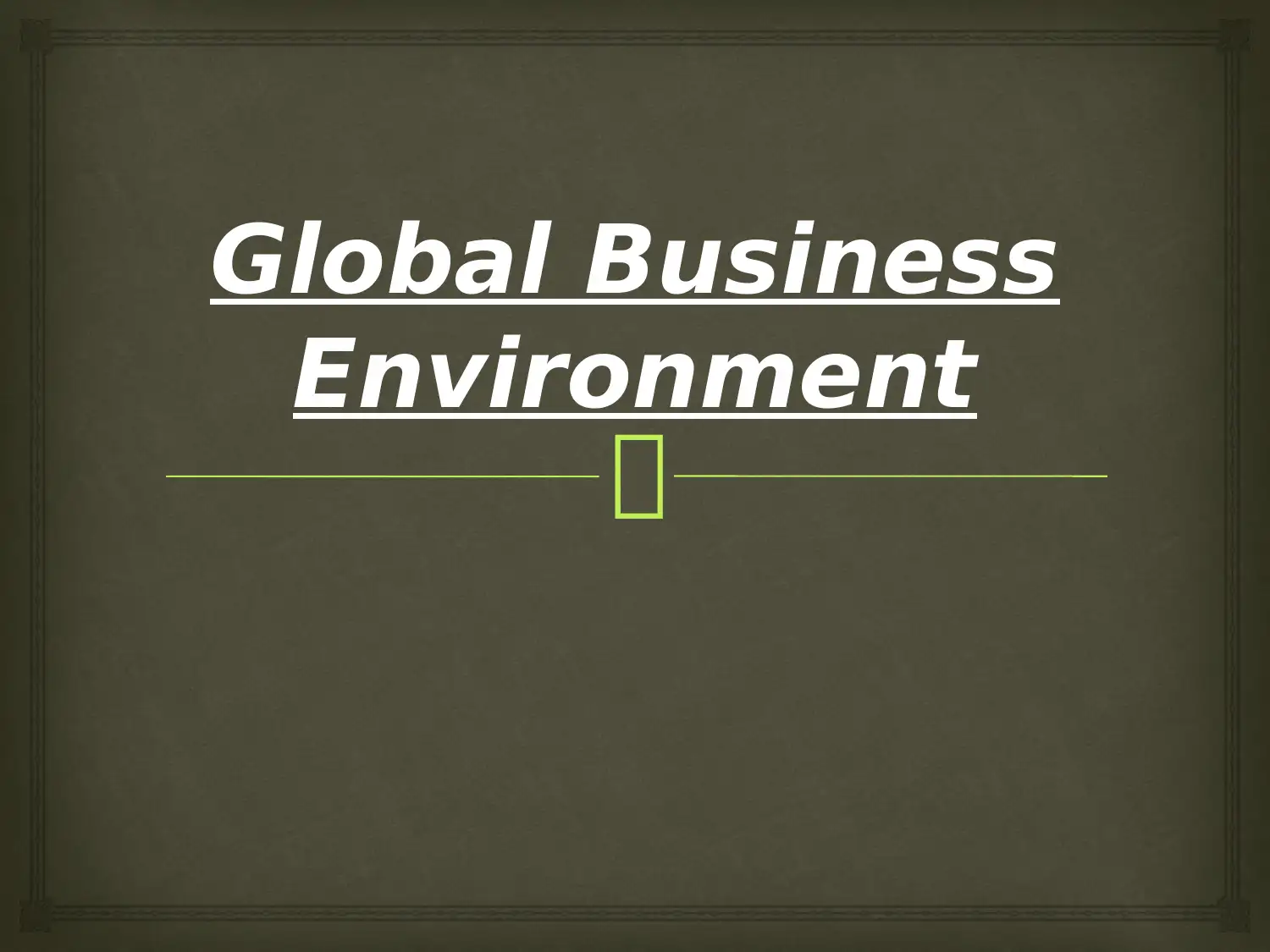
Global Business
Environment
Global Business
Environment
Paraphrase This Document
Need a fresh take? Get an instant paraphrase of this document with our AI Paraphraser
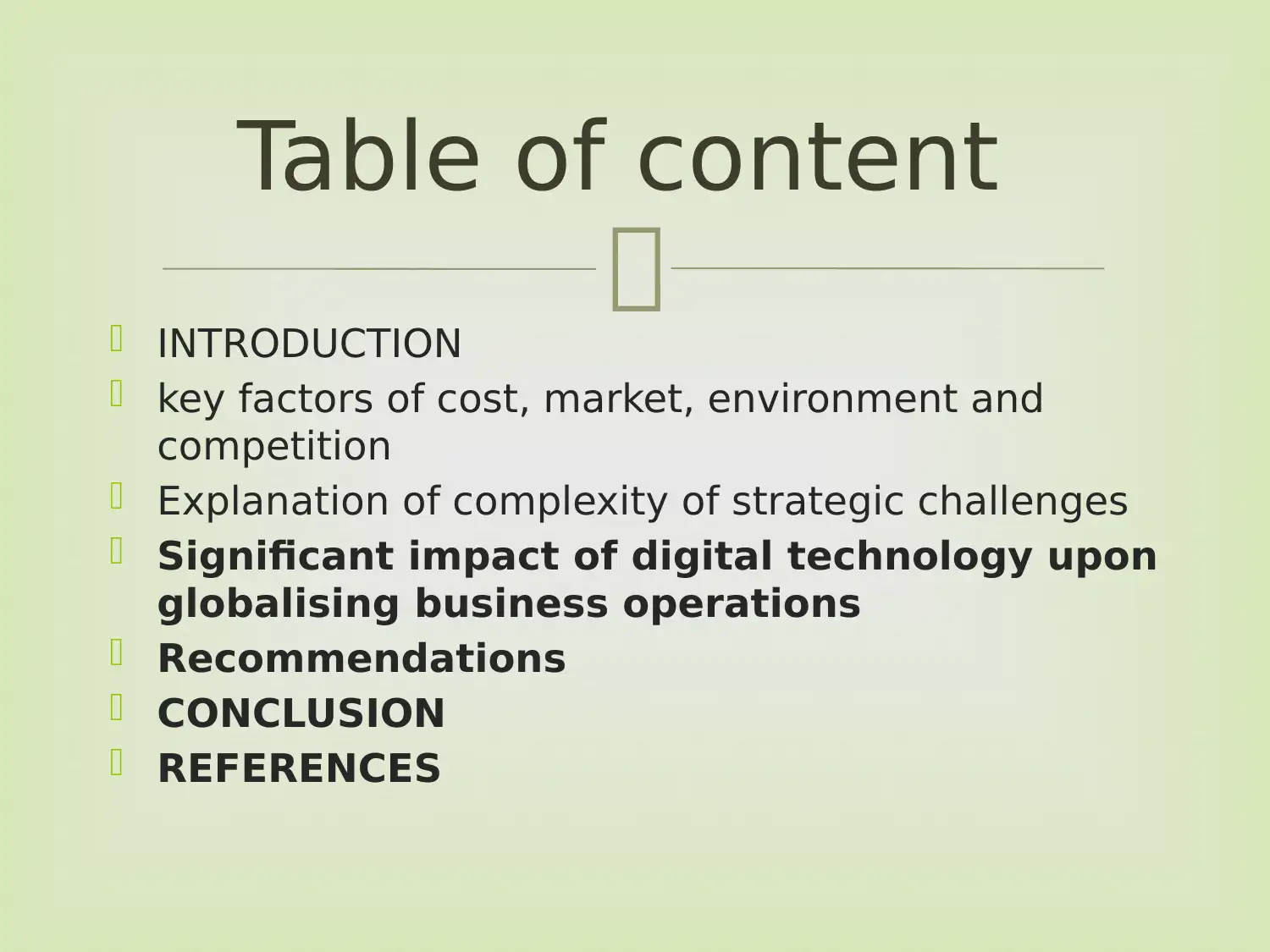
INTRODUCTION
key factors of cost, market, environment and
competition
Explanation of complexity of strategic challenges
Significant impact of digital technology upon
globalising business operations
Recommendations
CONCLUSION
REFERENCES
Table of content
INTRODUCTION
key factors of cost, market, environment and
competition
Explanation of complexity of strategic challenges
Significant impact of digital technology upon
globalising business operations
Recommendations
CONCLUSION
REFERENCES
Table of content
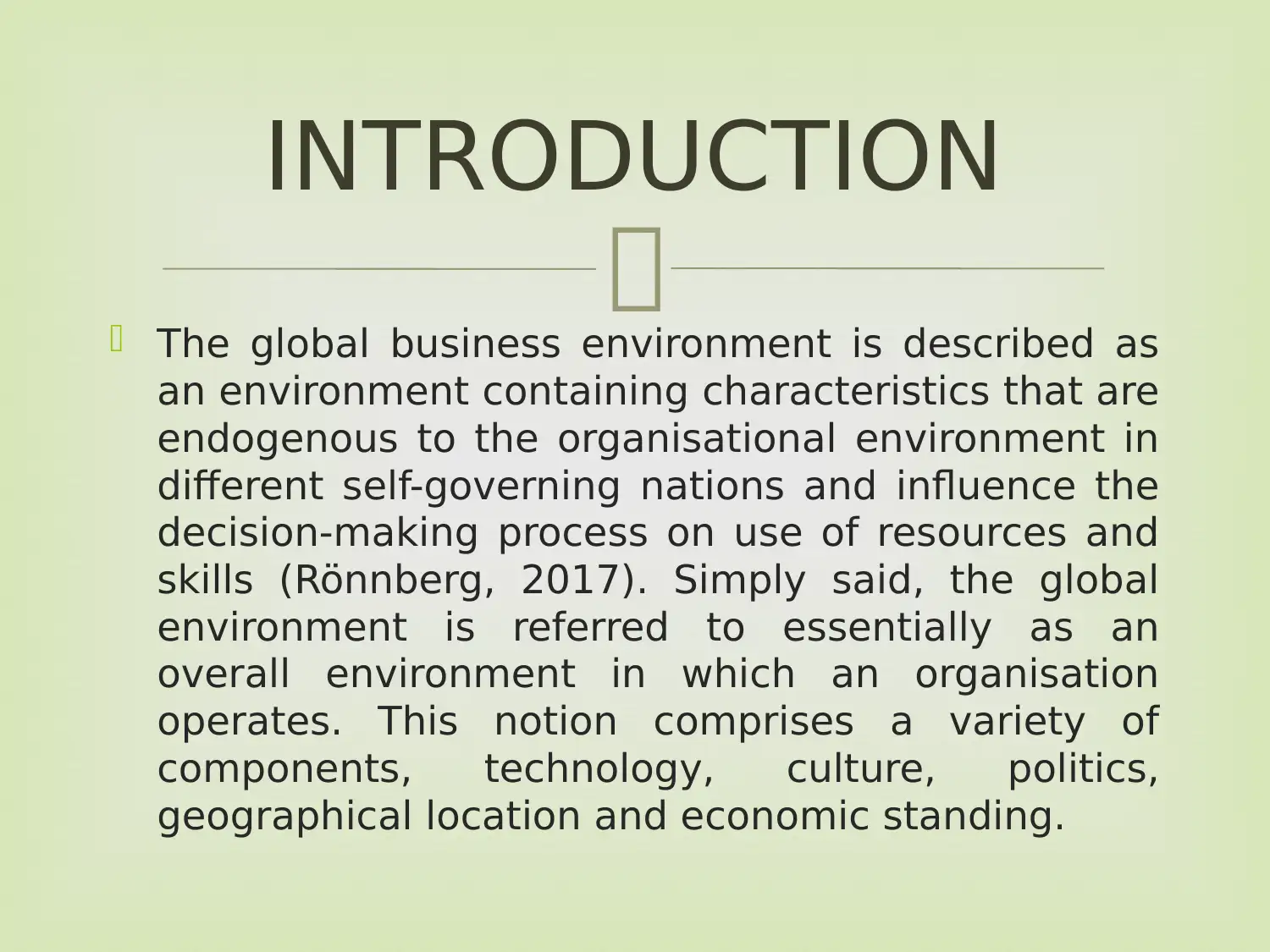
The global business environment is described as
an environment containing characteristics that are
endogenous to the organisational environment in
different self-governing nations and influence the
decision-making process on use of resources and
skills (Rönnberg, 2017). Simply said, the global
environment is referred to essentially as an
overall environment in which an organisation
operates. This notion comprises a variety of
components, technology, culture, politics,
geographical location and economic standing.
INTRODUCTION
The global business environment is described as
an environment containing characteristics that are
endogenous to the organisational environment in
different self-governing nations and influence the
decision-making process on use of resources and
skills (Rönnberg, 2017). Simply said, the global
environment is referred to essentially as an
overall environment in which an organisation
operates. This notion comprises a variety of
components, technology, culture, politics,
geographical location and economic standing.
INTRODUCTION
⊘ This is a preview!⊘
Do you want full access?
Subscribe today to unlock all pages.

Trusted by 1+ million students worldwide
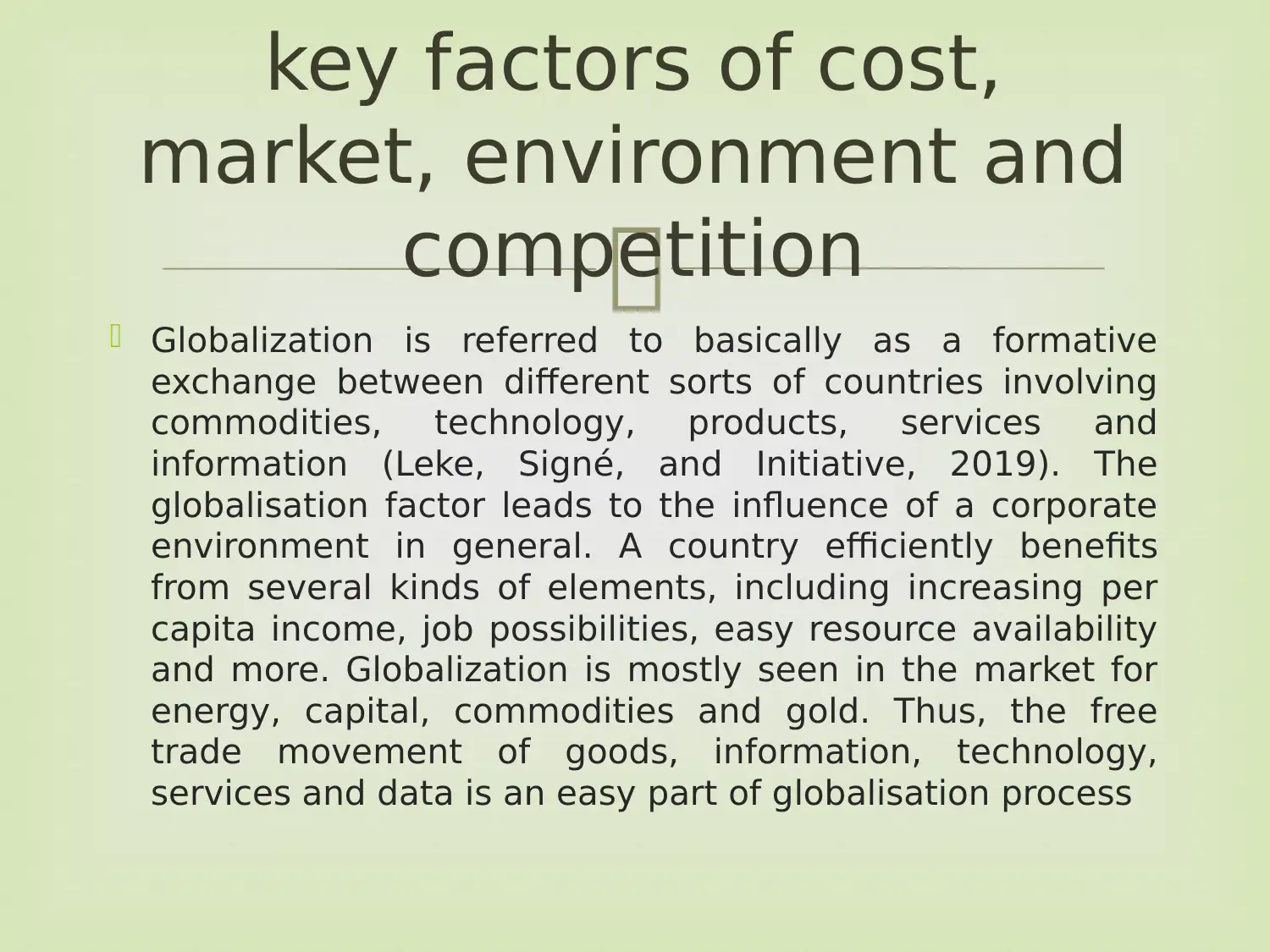
Globalization is referred to basically as a formative
exchange between different sorts of countries involving
commodities, technology, products, services and
information (Leke, Signé, and Initiative, 2019). The
globalisation factor leads to the influence of a corporate
environment in general. A country efficiently benefits
from several kinds of elements, including increasing per
capita income, job possibilities, easy resource availability
and more. Globalization is mostly seen in the market for
energy, capital, commodities and gold. Thus, the free
trade movement of goods, information, technology,
services and data is an easy part of globalisation process
key factors of cost,
market, environment and
competition
Globalization is referred to basically as a formative
exchange between different sorts of countries involving
commodities, technology, products, services and
information (Leke, Signé, and Initiative, 2019). The
globalisation factor leads to the influence of a corporate
environment in general. A country efficiently benefits
from several kinds of elements, including increasing per
capita income, job possibilities, easy resource availability
and more. Globalization is mostly seen in the market for
energy, capital, commodities and gold. Thus, the free
trade movement of goods, information, technology,
services and data is an easy part of globalisation process
key factors of cost,
market, environment and
competition
Paraphrase This Document
Need a fresh take? Get an instant paraphrase of this document with our AI Paraphraser
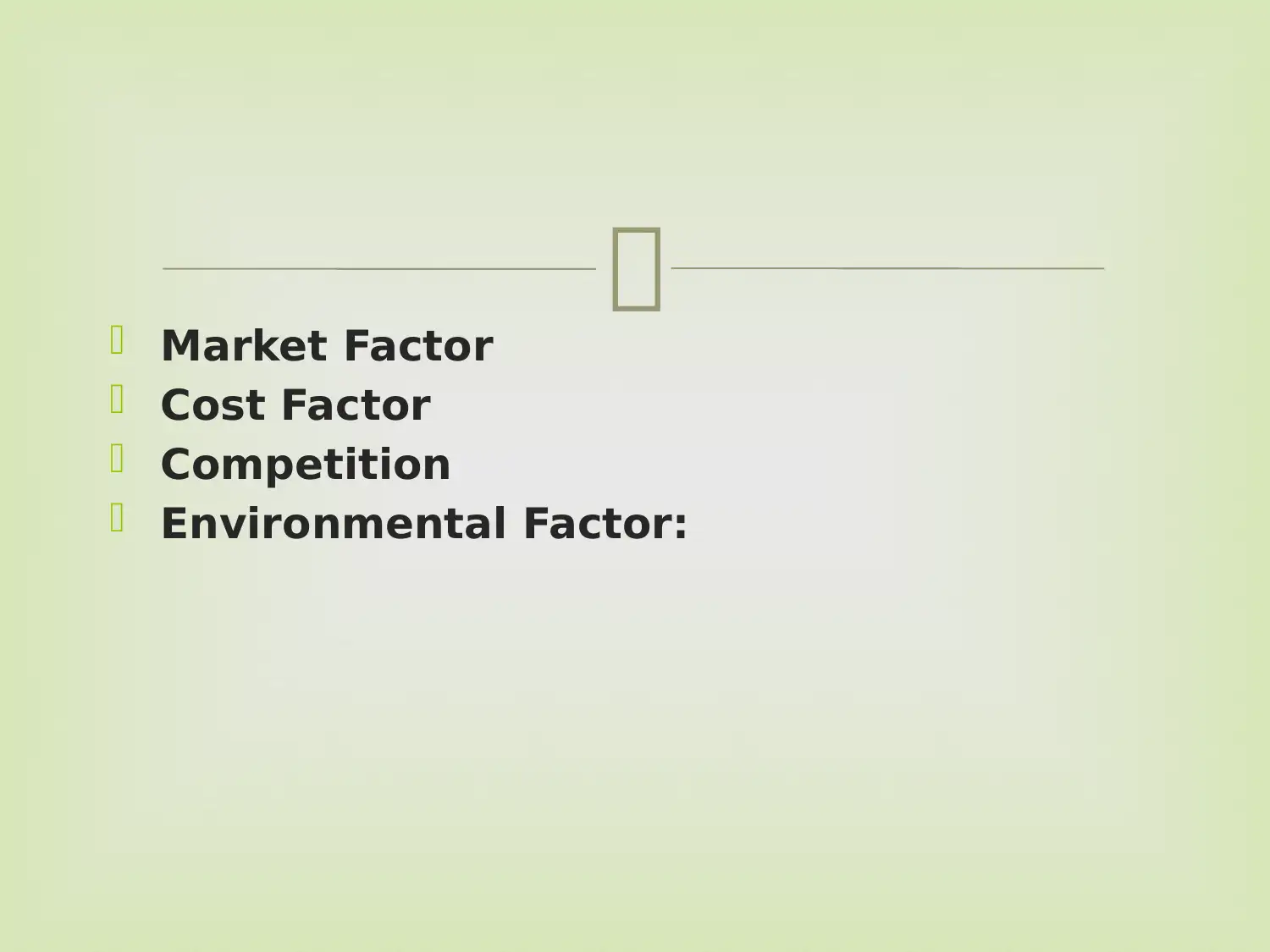
Market Factor
Cost Factor
Competition
Environmental Factor:
Market Factor
Cost Factor
Competition
Environmental Factor:
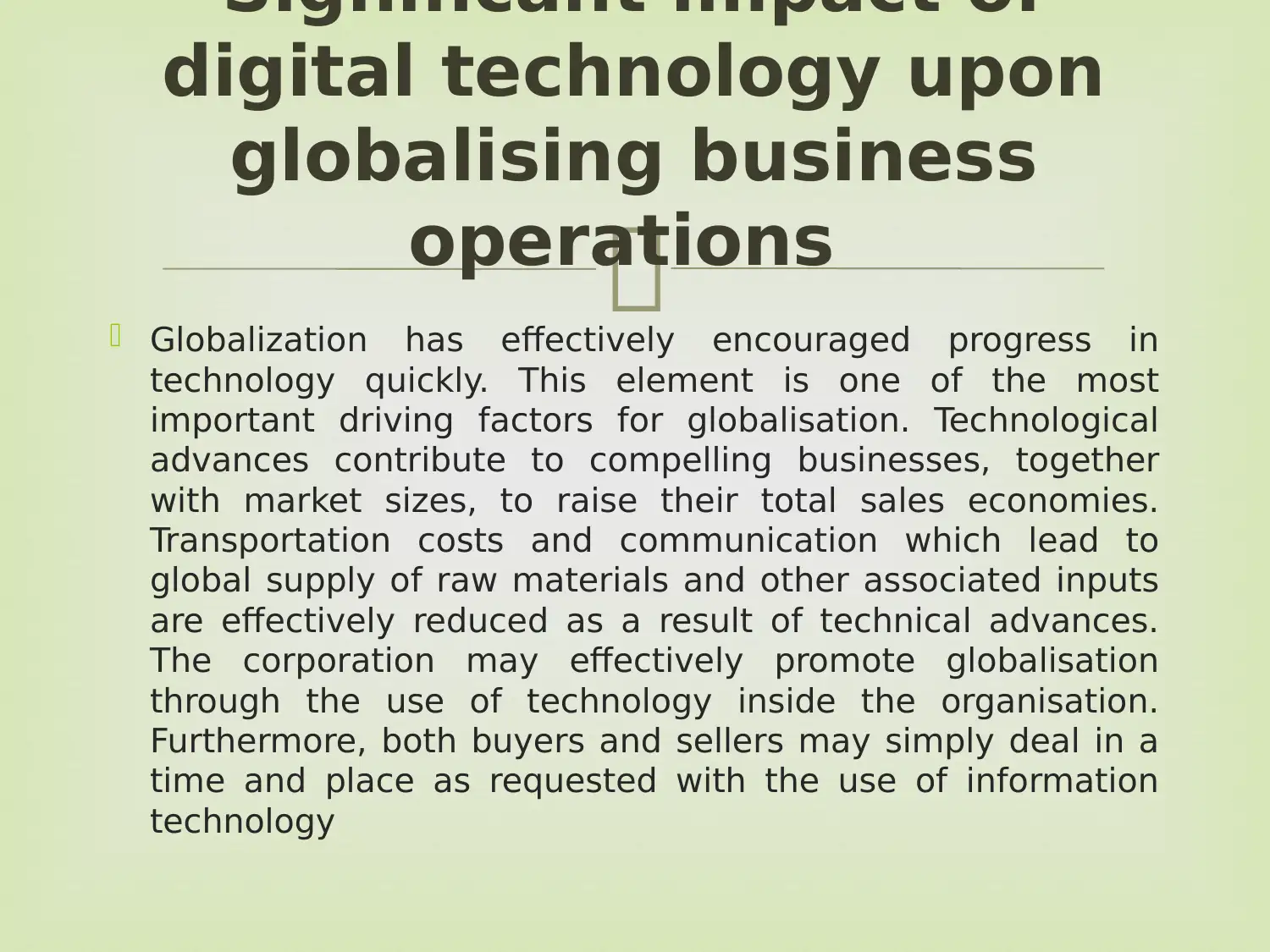
Globalization has effectively encouraged progress in
technology quickly. This element is one of the most
important driving factors for globalisation. Technological
advances contribute to compelling businesses, together
with market sizes, to raise their total sales economies.
Transportation costs and communication which lead to
global supply of raw materials and other associated inputs
are effectively reduced as a result of technical advances.
The corporation may effectively promote globalisation
through the use of technology inside the organisation.
Furthermore, both buyers and sellers may simply deal in a
time and place as requested with the use of information
technology
Significant impact of
digital technology upon
globalising business
operations
Globalization has effectively encouraged progress in
technology quickly. This element is one of the most
important driving factors for globalisation. Technological
advances contribute to compelling businesses, together
with market sizes, to raise their total sales economies.
Transportation costs and communication which lead to
global supply of raw materials and other associated inputs
are effectively reduced as a result of technical advances.
The corporation may effectively promote globalisation
through the use of technology inside the organisation.
Furthermore, both buyers and sellers may simply deal in a
time and place as requested with the use of information
technology
Significant impact of
digital technology upon
globalising business
operations
⊘ This is a preview!⊘
Do you want full access?
Subscribe today to unlock all pages.

Trusted by 1+ million students worldwide
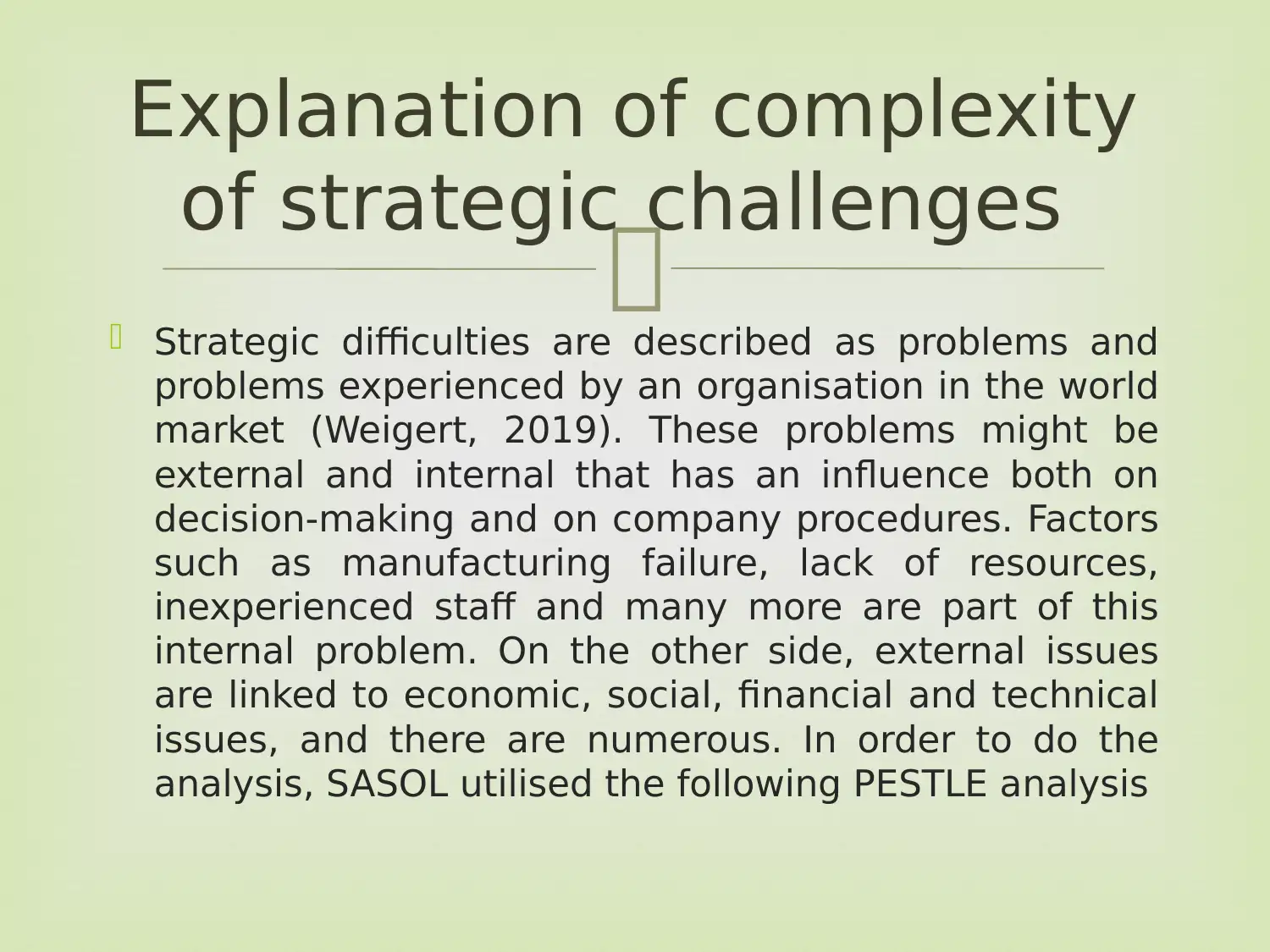
Strategic difficulties are described as problems and
problems experienced by an organisation in the world
market (Weigert, 2019). These problems might be
external and internal that has an influence both on
decision-making and on company procedures. Factors
such as manufacturing failure, lack of resources,
inexperienced staff and many more are part of this
internal problem. On the other side, external issues
are linked to economic, social, financial and technical
issues, and there are numerous. In order to do the
analysis, SASOL utilised the following PESTLE analysis
Explanation of complexity
of strategic challenges
Strategic difficulties are described as problems and
problems experienced by an organisation in the world
market (Weigert, 2019). These problems might be
external and internal that has an influence both on
decision-making and on company procedures. Factors
such as manufacturing failure, lack of resources,
inexperienced staff and many more are part of this
internal problem. On the other side, external issues
are linked to economic, social, financial and technical
issues, and there are numerous. In order to do the
analysis, SASOL utilised the following PESTLE analysis
Explanation of complexity
of strategic challenges
Paraphrase This Document
Need a fresh take? Get an instant paraphrase of this document with our AI Paraphraser
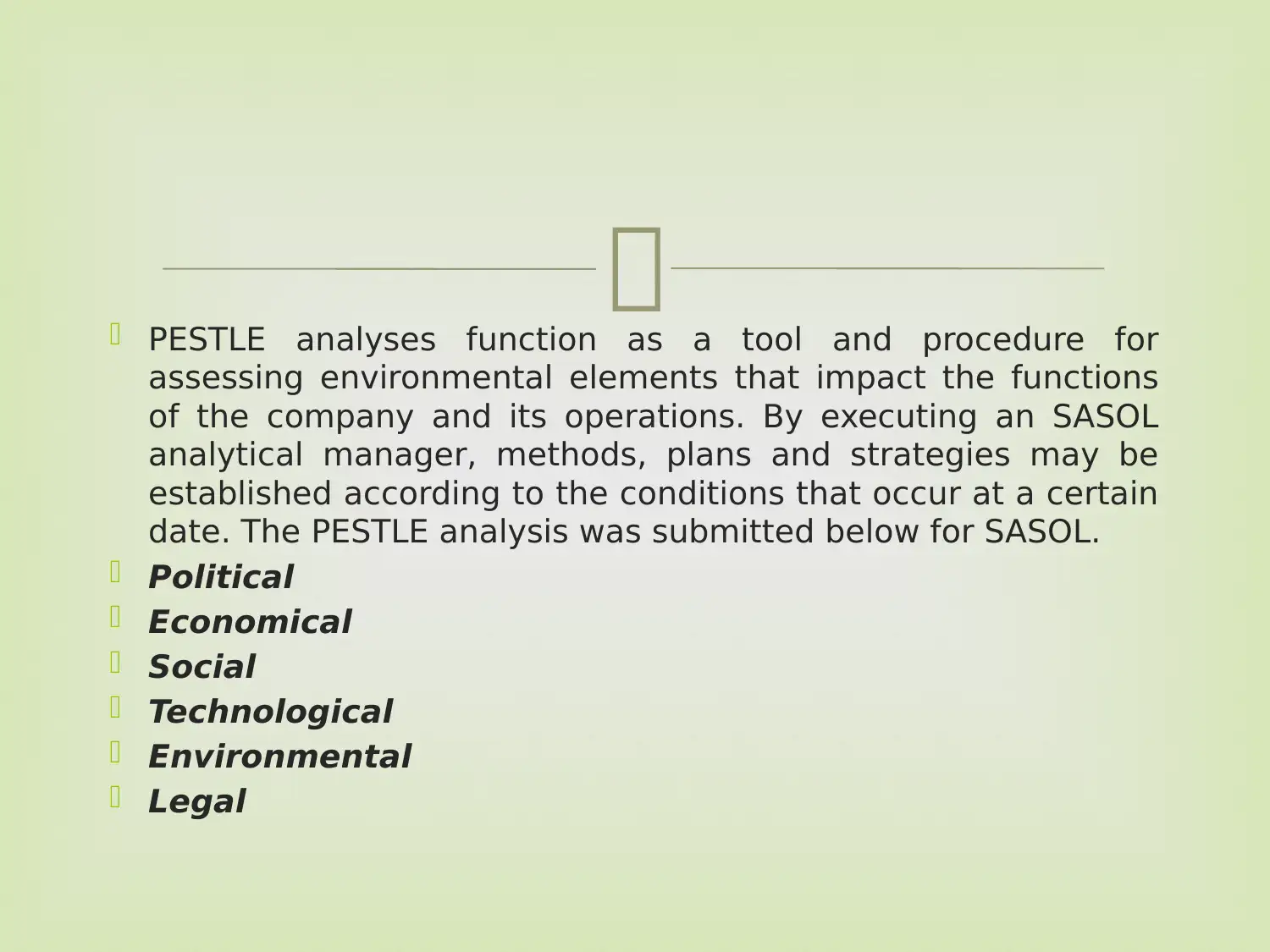
PESTLE analyses function as a tool and procedure for
assessing environmental elements that impact the functions
of the company and its operations. By executing an SASOL
analytical manager, methods, plans and strategies may be
established according to the conditions that occur at a certain
date. The PESTLE analysis was submitted below for SASOL.
Political
Economical
Social
Technological
Environmental
Legal
PESTLE analyses function as a tool and procedure for
assessing environmental elements that impact the functions
of the company and its operations. By executing an SASOL
analytical manager, methods, plans and strategies may be
established according to the conditions that occur at a certain
date. The PESTLE analysis was submitted below for SASOL.
Political
Economical
Social
Technological
Environmental
Legal
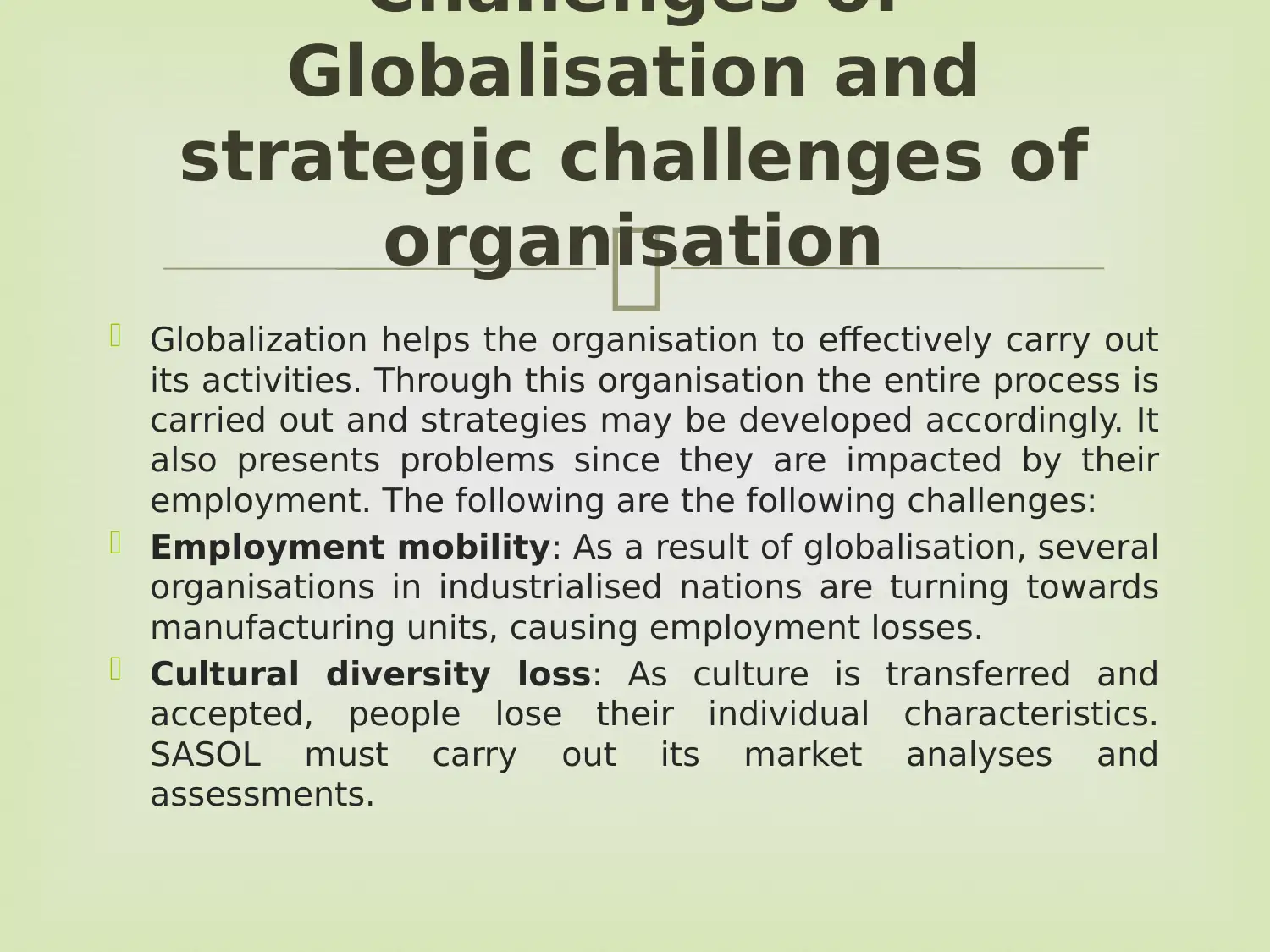
Globalization helps the organisation to effectively carry out
its activities. Through this organisation the entire process is
carried out and strategies may be developed accordingly. It
also presents problems since they are impacted by their
employment. The following are the following challenges:
Employment mobility: As a result of globalisation, several
organisations in industrialised nations are turning towards
manufacturing units, causing employment losses.
Cultural diversity loss: As culture is transferred and
accepted, people lose their individual characteristics.
SASOL must carry out its market analyses and
assessments.
Challenges of
Globalisation and
strategic challenges of
organisation
Globalization helps the organisation to effectively carry out
its activities. Through this organisation the entire process is
carried out and strategies may be developed accordingly. It
also presents problems since they are impacted by their
employment. The following are the following challenges:
Employment mobility: As a result of globalisation, several
organisations in industrialised nations are turning towards
manufacturing units, causing employment losses.
Cultural diversity loss: As culture is transferred and
accepted, people lose their individual characteristics.
SASOL must carry out its market analyses and
assessments.
Challenges of
Globalisation and
strategic challenges of
organisation
⊘ This is a preview!⊘
Do you want full access?
Subscribe today to unlock all pages.

Trusted by 1+ million students worldwide
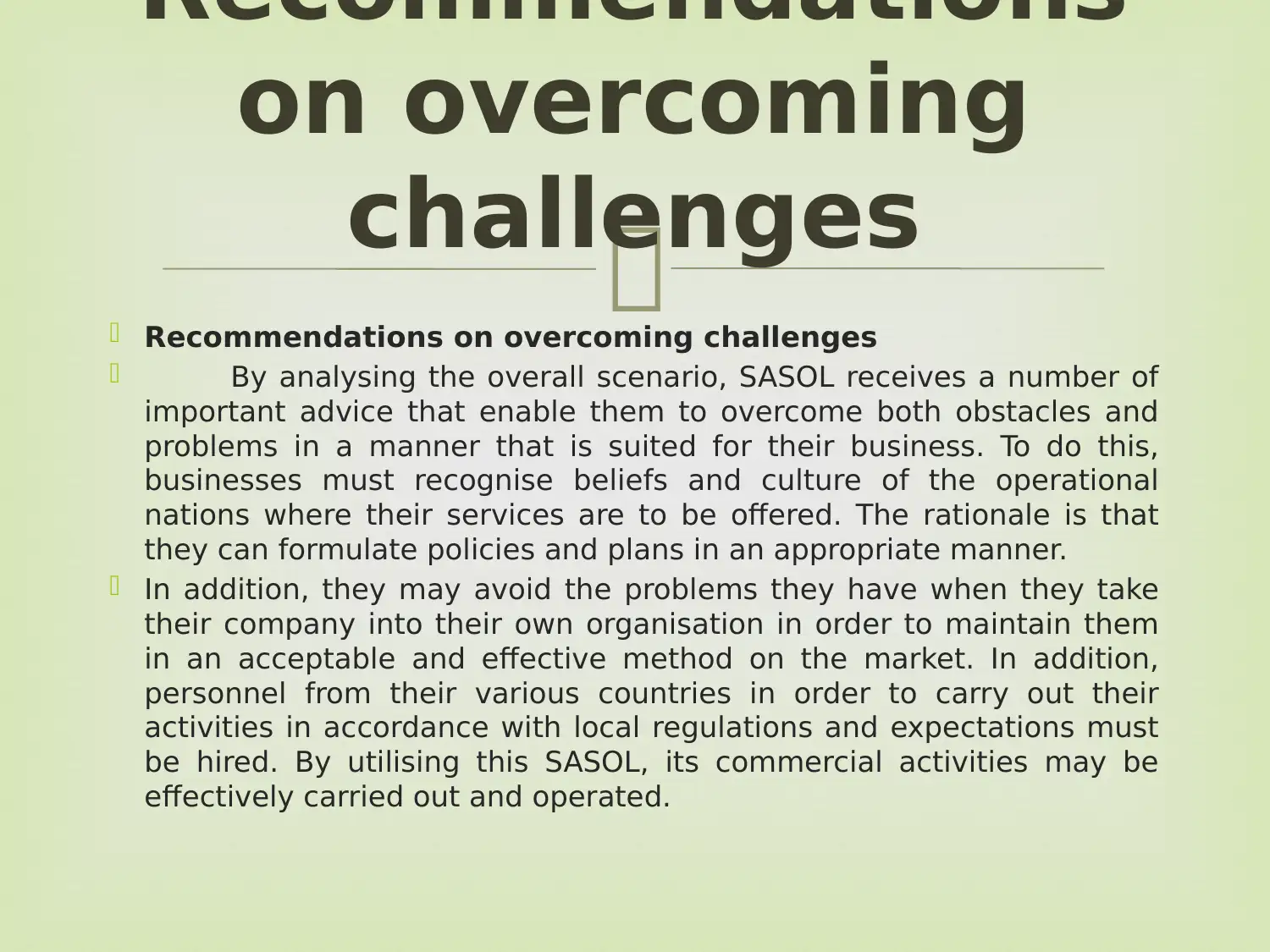
Recommendations on overcoming challenges
By analysing the overall scenario, SASOL receives a number of
important advice that enable them to overcome both obstacles and
problems in a manner that is suited for their business. To do this,
businesses must recognise beliefs and culture of the operational
nations where their services are to be offered. The rationale is that
they can formulate policies and plans in an appropriate manner.
In addition, they may avoid the problems they have when they take
their company into their own organisation in order to maintain them
in an acceptable and effective method on the market. In addition,
personnel from their various countries in order to carry out their
activities in accordance with local regulations and expectations must
be hired. By utilising this SASOL, its commercial activities may be
effectively carried out and operated.
Recommendations
on overcoming
challenges
Recommendations on overcoming challenges
By analysing the overall scenario, SASOL receives a number of
important advice that enable them to overcome both obstacles and
problems in a manner that is suited for their business. To do this,
businesses must recognise beliefs and culture of the operational
nations where their services are to be offered. The rationale is that
they can formulate policies and plans in an appropriate manner.
In addition, they may avoid the problems they have when they take
their company into their own organisation in order to maintain them
in an acceptable and effective method on the market. In addition,
personnel from their various countries in order to carry out their
activities in accordance with local regulations and expectations must
be hired. By utilising this SASOL, its commercial activities may be
effectively carried out and operated.
Recommendations
on overcoming
challenges
Paraphrase This Document
Need a fresh take? Get an instant paraphrase of this document with our AI Paraphraser
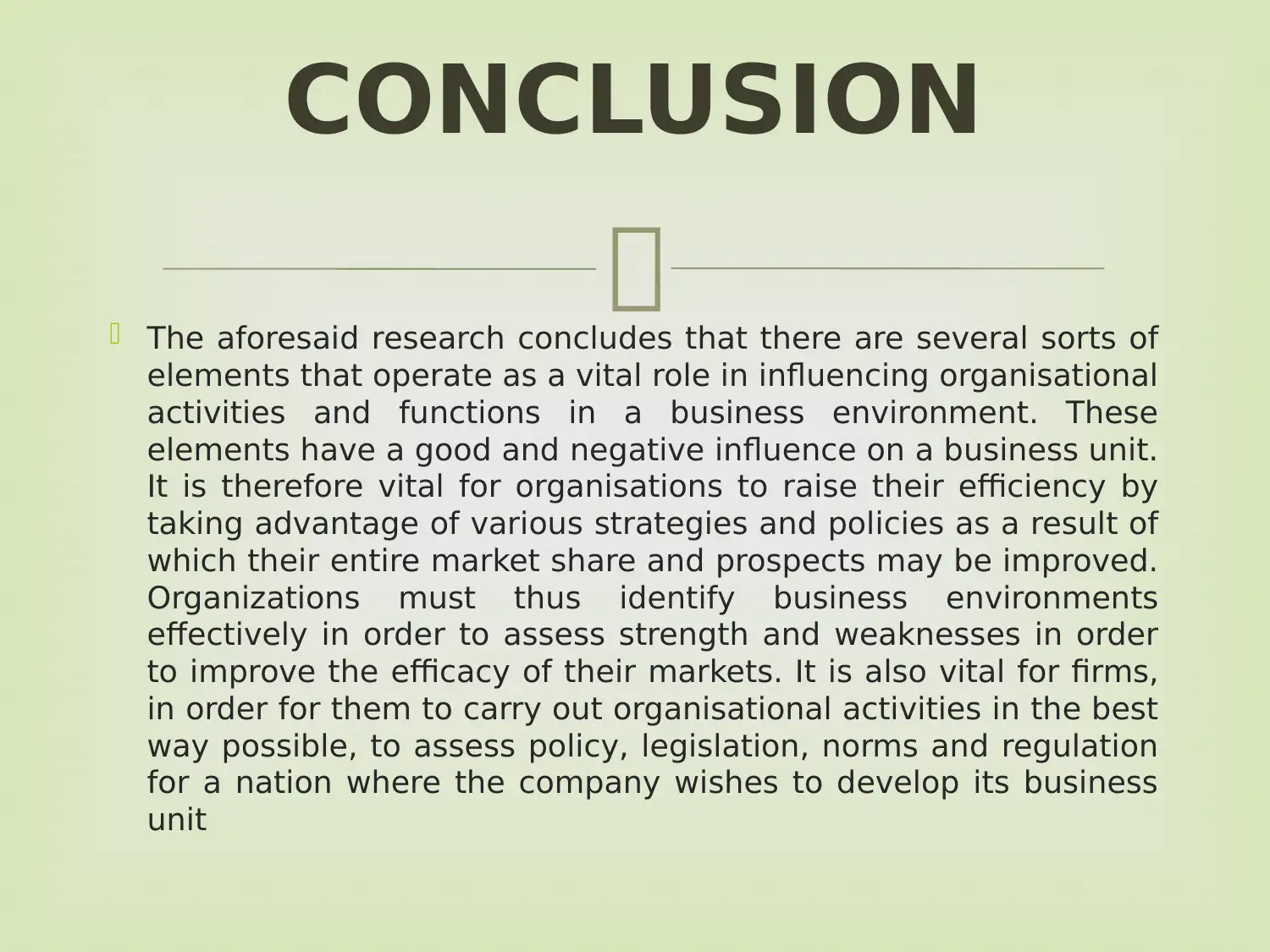
The aforesaid research concludes that there are several sorts of
elements that operate as a vital role in influencing organisational
activities and functions in a business environment. These
elements have a good and negative influence on a business unit.
It is therefore vital for organisations to raise their efficiency by
taking advantage of various strategies and policies as a result of
which their entire market share and prospects may be improved.
Organizations must thus identify business environments
effectively in order to assess strength and weaknesses in order
to improve the efficacy of their markets. It is also vital for firms,
in order for them to carry out organisational activities in the best
way possible, to assess policy, legislation, norms and regulation
for a nation where the company wishes to develop its business
unit
CONCLUSION
The aforesaid research concludes that there are several sorts of
elements that operate as a vital role in influencing organisational
activities and functions in a business environment. These
elements have a good and negative influence on a business unit.
It is therefore vital for organisations to raise their efficiency by
taking advantage of various strategies and policies as a result of
which their entire market share and prospects may be improved.
Organizations must thus identify business environments
effectively in order to assess strength and weaknesses in order
to improve the efficacy of their markets. It is also vital for firms,
in order for them to carry out organisational activities in the best
way possible, to assess policy, legislation, norms and regulation
for a nation where the company wishes to develop its business
unit
CONCLUSION
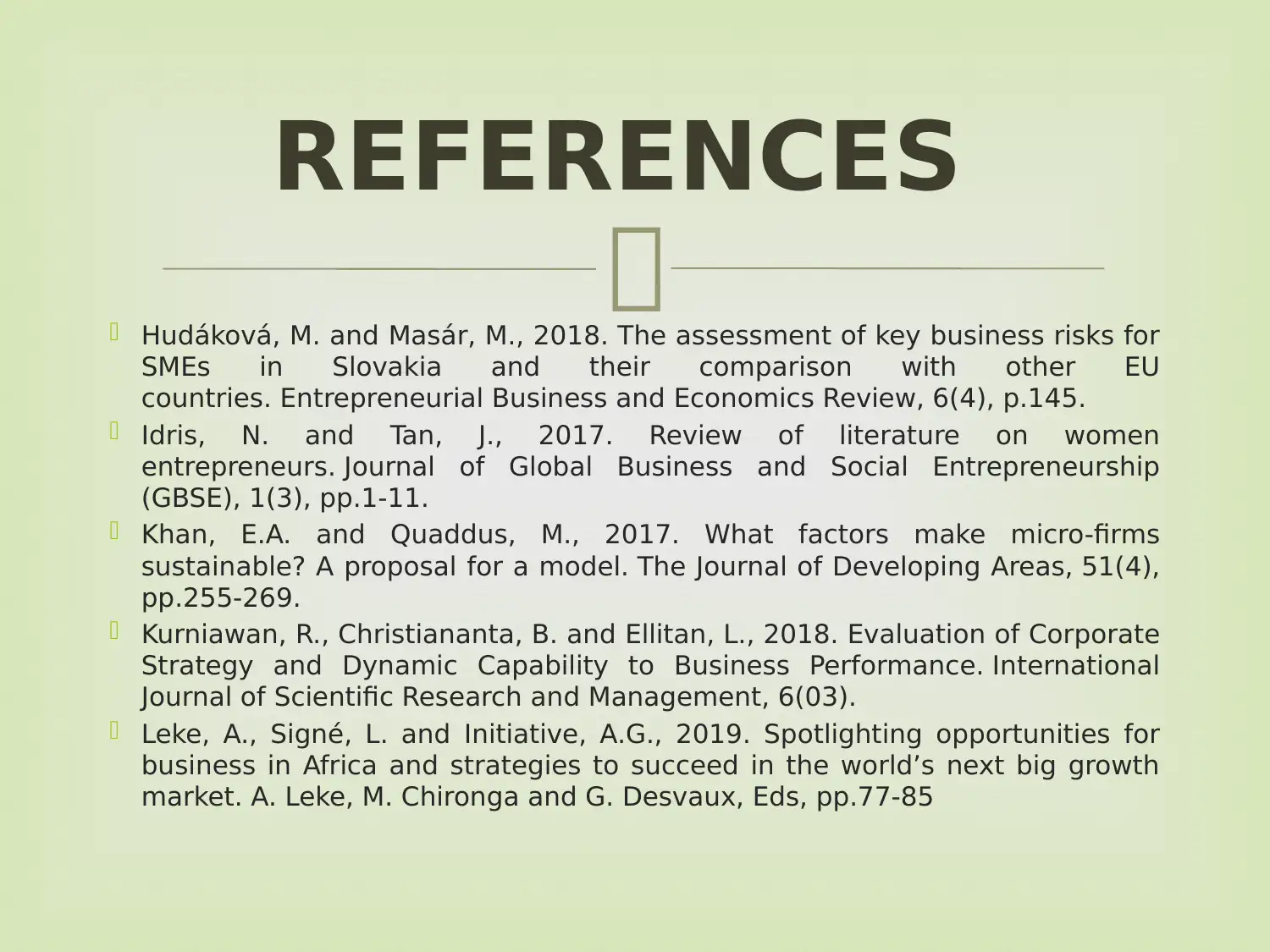
Hudáková, M. and Masár, M., 2018. The assessment of key business risks for
SMEs in Slovakia and their comparison with other EU
countries. Entrepreneurial Business and Economics Review, 6(4), p.145.
Idris, N. and Tan, J., 2017. Review of literature on women
entrepreneurs. Journal of Global Business and Social Entrepreneurship
(GBSE), 1(3), pp.1-11.
Khan, E.A. and Quaddus, M., 2017. What factors make micro-firms
sustainable? A proposal for a model. The Journal of Developing Areas, 51(4),
pp.255-269.
Kurniawan, R., Christiananta, B. and Ellitan, L., 2018. Evaluation of Corporate
Strategy and Dynamic Capability to Business Performance. International
Journal of Scientific Research and Management, 6(03).
Leke, A., Signé, L. and Initiative, A.G., 2019. Spotlighting opportunities for
business in Africa and strategies to succeed in the world’s next big growth
market. A. Leke, M. Chironga and G. Desvaux, Eds, pp.77-85
REFERENCES
SMEs in Slovakia and their comparison with other EU
countries. Entrepreneurial Business and Economics Review, 6(4), p.145.
Idris, N. and Tan, J., 2017. Review of literature on women
entrepreneurs. Journal of Global Business and Social Entrepreneurship
(GBSE), 1(3), pp.1-11.
Khan, E.A. and Quaddus, M., 2017. What factors make micro-firms
sustainable? A proposal for a model. The Journal of Developing Areas, 51(4),
pp.255-269.
Kurniawan, R., Christiananta, B. and Ellitan, L., 2018. Evaluation of Corporate
Strategy and Dynamic Capability to Business Performance. International
Journal of Scientific Research and Management, 6(03).
Leke, A., Signé, L. and Initiative, A.G., 2019. Spotlighting opportunities for
business in Africa and strategies to succeed in the world’s next big growth
market. A. Leke, M. Chironga and G. Desvaux, Eds, pp.77-85
REFERENCES
⊘ This is a preview!⊘
Do you want full access?
Subscribe today to unlock all pages.

Trusted by 1+ million students worldwide
1 out of 12
Related Documents
Your All-in-One AI-Powered Toolkit for Academic Success.
+13062052269
info@desklib.com
Available 24*7 on WhatsApp / Email
![[object Object]](/_next/static/media/star-bottom.7253800d.svg)
Unlock your academic potential
Copyright © 2020–2025 A2Z Services. All Rights Reserved. Developed and managed by ZUCOL.

